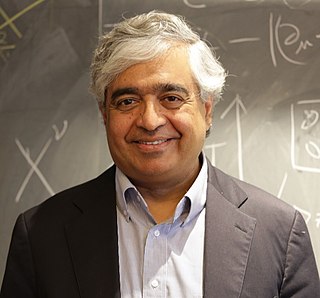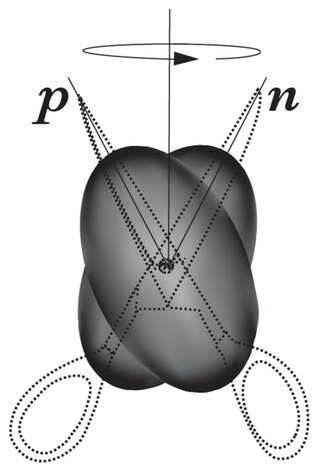Related Research Articles
A tetraneutron is a hypothetical stable cluster of four neutrons. The existence of this cluster of particles is not supported by current models of nuclear forces. There is some empirical evidence suggesting that this particle does exist, based on a 2001 experiment by Francisco-Miguel Marqués and co-workers at the Ganil accelerator in Caen using a novel detection method in observations of the disintegration of beryllium and lithium nuclei. However, subsequent attempts to replicate this observation have failed.
An axion is a hypothetical elementary particle originally postulated by the Peccei–Quinn theory in 1977 to resolve the strong CP problem in quantum chromodynamics (QCD). If axions exist and have low mass within a specific range, they are of interest as a possible component of cold dark matter.
In physics, mirror matter, also called shadow matter or Alice matter, is a hypothetical counterpart to ordinary matter.
The Abraham–Minkowski controversy is a physics debate concerning electromagnetic momentum within dielectric media. Two equations were first suggested by Hermann Minkowski (1908) and Max Abraham (1909) for this momentum. They predict different values, from which the name of the controversy derives. Experimental support has been claimed for both.
In particle physics, hexaquarks, alternatively known as sexaquarks, are a large family of hypothetical particles, each particle consisting of six quarks or antiquarks of any flavours. Six constituent quarks in any of several combinations could yield a colour charge of zero; for example a hexaquark might contain either six quarks, resembling two baryons bound together, or three quarks and three antiquarks. Once formed, dibaryons are predicted to be fairly stable by the standards of particle physics.
A strangelet is a hypothetical particle consisting of a bound state of roughly equal numbers of up, down, and strange quarks. An equivalent description is that a strangelet is a small fragment of strange matter, small enough to be considered a particle. The size of an object composed of strange matter could, theoretically, range from a few femtometers across to arbitrarily large. Once the size becomes macroscopic, such an object is usually called a strange star. The term "strangelet" originates with Edward Farhi and Robert Jaffe in 1984. Strangelets can convert matter to strange matter on contact. Strangelets have been suggested as a dark matter candidate.

Subir Sachdev is Herchel Smith Professor of Physics at Harvard University specializing in condensed matter. He was elected to the U.S. National Academy of Sciences in 2014, received the Lars Onsager Prize from the American Physical Society and the Dirac Medal from the ICTP in 2018, and was elected Foreign Member of the Royal Society ForMemRS in 2023. He was a co-editor of the Annual Review of Condensed Matter Physics 2017–2019, and is Editor-in-Chief of Reports on Progress in Physics 2022-.

Gerald Edward Brown was an American theoretical physicist who worked on nuclear physics and astrophysics. Since 1968 he had been a professor at the Stony Brook University. He was a distinguished professor emeritus of the C. N. Yang Institute for Theoretical Physics at Stony Brook University.
Maya Paczuski is the head and founder of the Complexity Science Group at the University of Calgary. She is a well-cited physicist whose work spans self-organized criticality, avalanche dynamics, earthquake, and complex networks. She was born in Israel in 1963, but grew up in the United States. Maya Paczuski received a B.S. and M.S. in Electrical Engineering and Computer Science from M.I.T. in 1986 and then went on to study with Mehran Kardar, earning her Ph.D in Condensed matter physics from the same institute.

Scissors Modes are collective excitations in which two particle systems move with respect to each other conserving their shape. For the first time they were predicted to occur in deformed atomic nuclei by N. LoIudice and F. Palumbo, who used a semiclassical Two Rotor Model, whose solution required a realization of the O(4) algebra that was not known in mathematics. In this model protons and neutrons were assumed to form two interacting rotors to be identified with the blades of scissors. Their relative motion (Fig.1) generates a magnetic dipole moment whose coupling with the electromagnetic field provides the signature of the mode.
James Michael Lattimer is a nuclear astrophysicist who works on the dense nuclear matter equation of state and neutron stars. He is currently a distinguished professor at Stony Brook University.
Ramamurti Rajaraman is an emeritus professor of theoretical physics at the School of Physical Sciences at Jawaharlal Nehru University. He was also the co-Chairman of the International Panel on Fissile Materials and a member of the Bulletin of the Atomic Scientists' Science and Security Board. He has taught and conducted research in physics at the Indian Institute of Science, the Institute for Advanced Study at Princeton, and as a visiting professor at Stanford, Harvard, MIT, and elsewhere. He received his doctorate in theoretical physics in 1963 from Cornell University. In addition to his physics publications, Rajaraman has written widely on topics including fissile material production in India and Pakistan and the radiological effects of nuclear weapon accidents.
In nuclear physics, the symmetry energy reflects the variation of the binding energy of the nucleons in the nuclear matter depending on its neutron to proton ratio as a function of baryon density. Symmetry energy is an important parameter in the equation of state describing the nuclear structure of heavy nuclei and neutron stars.
Tin-Lun "Jason" Ho is a Chinese-American theoretical physicist, specializing in condensed matter theory, quantum gases, and Bose-Einstein condensates. He is known for the Mermin-Ho relation.
Alan Harold Luther is an American physicist, specializing in condensed matter physics.

ANAIS is a dark matter direct detection experiment located at the Canfranc Underground Laboratory (LSC), in Spain.
Blayne Ryan Heckel is an American experimental physicist, known for his research involving precision measurements in atomic physics and gravitational physics. He is now a professor emeritus at the University of Washington in Seattle.
Madappa Prakash is an Indian-American nuclear physicist and astrophysicist, known for his research on the physics of neutron stars and heavy-ion collisions.
Dov I. Levine is an American-Israeli physicist, known for his research on quasicrystals, soft condensed matter physics, and statistical mechanics out of equilibrium.
Leo Radzihovsky is a Russian American condensed matter physicist and academic serving as a professor of Distinction in Physics at the University of Colorado Boulder.
References
- 1 2 3 "C. J. Pethick, Emeritus". Niels Bohr Institute, University of Copenhagen. 10 September 2007.
- ↑ "APS Announces Spring 2011 Prize and Award Recipients" (PDF). APS News, American Physical Society. Spring 2011.
- ↑ "2008 Lars Onsager Prize Recipient, Christopher Pethick". American Physical Society.
- ↑ "2011 Hans A. Bethe Prize Recipient, Christopher Pethick". American Physical Society.
- ↑ "Christopher Pethick receives the Feenberg Award". Niels Bohr Institute, University of Copenhagen. 18 August 2015.
- ↑ "Pethick, Christopher". Royalacademy.dk.
- ↑ "APS Fellow Archive, search on year 1985 and institution NORDITA". American Physical Society.
- ↑ "Member History: Christopher John Pethick". American Philosophical Society.